LA SALA Ground Floor, 23 Foster Street
Surry Hills, Sydney
www.lasala.com.auChef: Darren Simpson
La Sala is a collaboration between Restaurant Manager Andrea Mellas (Otto Ristorante, Icebergs Dining Room & Bar) and TV fame chef Darren Simpson (Le Gavroche, River Café, Aqua Luna).

I started my birthday dinner off in La Sala's swanky bar area with a blood peach bellini ($14), the traditional nectar and prosecco aperitif. The peaches were a little unripe but the bar had done an excellent job of sweetening them subtly so it was almost undetectable.

When we descended downstairs to our table, I ordered two Port Stephen rock oysters ($3.50 each), which came with shallot vinegar. The oysters were simply divine – creamy, a light taste of the sea. We also snacked on a bowl of rosemary and garlic marinated olives ($7).
When it came to ordering Jonas was happy to see that vegetarians have their very own menu with imaginative options. He chose the vedure mista ($16) and received a variety of vegetables, each cooked a different way. Green beans, tossed in olive oil, were topped with a salsa of kalamata olives and pine nuts; long, thin slices of zucchini and eggplant were gently chargrilled; white beans were stewed with tomatoes and topped with fresh oregano; mushrooms had been fried deliciously. What Jonas appreciated most was that every vegetable was enhanced differently and yet the natural flavour of each vegetable was present.
2004 Campagnola Soave Classico ‘Le Bine’, also from Veneto ($11)I opted for the carpaccio cipriani ($18) and it was the best I have ever eaten in Australia, or even Italy. This was truly a salute to the original carpaccio from Harry’s Bar (owned by Giuseppe Cipriani): the thinnest slices of raw beef cross-hatched with a classic carpaccio sauce of mayonnaise, flavoured with lemon juice and worchestershire sauce. It was then topped with olive oil and freshly milled black pepper, and served with a wedge

of lemon. The beef had a delicious subtle flavour and the mayonnaise seemed to have been made with olive oil because it exuded a wonderful fragrance. I was in absolute heaven.
Frescobaldi 'Danzante' Pinot Grigio from Veneto, Italy ($10.50)
I then ordered two entrées instead of a main and both were very good. First was the caldo vedure ($15), which on this day was an organic kale and cod soup. The cod flakes added a light saltiness to the very delicately flavoured chicken broth and the kale provided texture and a pleasant ferric bitterness. Potatoes were perfect little cubes that broke apart easily in the mouth and the gorgeous purple hues of kale and dark cavolo nero added colour.

My second dish was the whitebait and potato pancake ($22), which arrived at the table like a plump, golden blini, flecked with chives, and topped with a quenelle of crème fraîche and vibrantly orange Yarra Valley salmon roe. The pancake was firm and gold on the outside with a soft, creamy interior. The crème fraîche added sour lactic oomph and the robust pearls of roe provided bursts of sweet saltiness. Although very decorative, potentially they could have served less caviar.
2003 Will Taylor Riesling from Clare Valley, South Australia ($9.50)
Jonas’ main was also unique: tagliatelle ortiche e gorgonzola ($30). It was the only special of the night and came in entrée and main sizes. This dish used stinging nettles, cooked until they formed a vibrant green sauce. The nettles were then smothered over the tagliatelle, their earthy, verdant flavour contrasting subtly with the light gorgonzola dolce sauce. Topped with a sprinkling of parmigiano this was a subtle yet extremely invigorating dish using rare ingredients.
2004 Jeremiah One Pinot Noir from Lenswood, South Australia ($9)


For dessert, Jonas was ridiculously full and decided to have a cognac rather than the cheese platter he had originally planned. He ordered the Hennessy XO ($24) of which 30ml arrived in a warmed brandy balloon.
I pounced upon the mela cotogna ($15), or honey roasted quince. Served with a vanilla ice cream was bright yellow quince flesh, perfectly textured with a soft resistance and smothered in a rich honey glaze. I was really pleased with this choice.

Jonas was very impressed by the service (he’s a waiter, so that should mean something) and although I am still in two minds, I have to admit my unease is potentially unfounded.
The staff were conscious of customer needs and quite attentive, but unfortunately I felt tables of older patrons received that little bit extra. To be fair to the waiters, experience tells them that this is where their big tips will come from, so I can’t really fault them for leaning towards older customers. On the other hand I had to watch the waiter seemingly fawn over the tables next to and behind us. We were treated very well, but I felt they got it better. Jealousy? I honestly can’t say.
Nonetheless, we were seated quickly and introduced to the only special for the evening, then walked through the menu. We were given time to make a decision and then he returned for any last minute questions before taking our order. My queries over wines to match my meal was answered, although not confidently, which concerned me a little.
The wait staff visited unobtrusively throughout the evening, checking on water, wine and whether everything was to our satisfaction. Courses were delivered with perfect timing in between and overall the waiters were friendly, knowledgeable and professional.
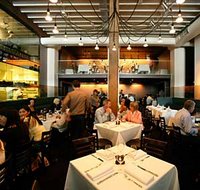
In terms of ambience and décor, I could go as far as to say that this dining room is now my most favourite in Sydney. The room is low lit but has a warm glow from the frosted glass candle holders and the delicate wrought iron chandeliers that radiate out from their centres like spidery petals. The use of dark wood and chocolaty coloured upholstery exudes elegance and the long glass window into the kitchen certainly provides entertainment, especially when you catch a glimpse of the chef doing his thing. I found the room to be very elegant, very modern and yet still extremely warm and inviting.
(This photo of the dining room is courtesy of SMH)I have only two comments for improvement: first, the tables for two were much too small to fit all our wine glasses, water glasses, olive bowl, oyster plate, breads and olive oils, courses etc etc. Secondly, the room is so dim that it was only through taking photos that I saw how gorgeously presented my food was. In fact, every dish was exquisitely composed – colours were vibrant and beautiful but no diner ever sees this in such romantic darkness.
The total price for two, including a 13% tip, was $255. We both were pleasantly surprised that the bill was so reasonable – especially when compared to other restaurants of this calibre. It included cocktails, appetisers, 4 entrées, 1 main and 1 dessert as well as 4 glasses of wine and a cognac. A bargain for such a good meal.
This is certainly a place to return to. Prices were very reasonable, produce was excellent and the food coming from the kitchen was superb. The venue itself is very beautiful, creating a wonderful environment to wrap yourself in for an evening. Highly recommended.
 This is a perfect winter snack or side dish and it's very, very quick.
This is a perfect winter snack or side dish and it's very, very quick.


 It was a terrible way to end their World Cup campaign. The referee's decision is played over and over again in Australia. I almost wish the footage confirmed the ref's decision, but it clearly shows the Italian tripping over the Australian who was already on the ground.
It was a terrible way to end their World Cup campaign. The referee's decision is played over and over again in Australia. I almost wish the footage confirmed the ref's decision, but it clearly shows the Italian tripping over the Australian who was already on the ground. See how emotional I am over this game. Football fever!!!
See how emotional I am over this game. Football fever!!!

 Hola amigos! This weekend was a Mexican fiesta (partly Tex Mex) at my house.
Hola amigos! This weekend was a Mexican fiesta (partly Tex Mex) at my house. Horchata
Horchata Torta del Garbanzo
Torta del Garbanzo







 Olive Tapenade
Olive Tapenade
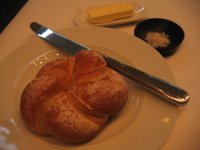 They quickly made me feel at home with a bottle of sparkling mineral water ($5) and a nice corner table where I could view the entire dining room, both upstairs and the main floor, although not the downstairs area with the view into the bustling kitchen.
They quickly made me feel at home with a bottle of sparkling mineral water ($5) and a nice corner table where I could view the entire dining room, both upstairs and the main floor, although not the downstairs area with the view into the bustling kitchen. Next was an amuse bouche of potato soup. It came in a tiny coffee cup and was decorated with foamy thyme chantilly and thyme leaves. The potato had been cooked in milk and butter and the soup had absorbed the flavour of butter and thyme perfectly. Yum.
Next was an amuse bouche of potato soup. It came in a tiny coffee cup and was decorated with foamy thyme chantilly and thyme leaves. The potato had been cooked in milk and butter and the soup had absorbed the flavour of butter and thyme perfectly. Yum. My bread was also very delicious. It seemed to be a sourdough, chewy on the outside and warm and soft inside. The floral shape it was baked in was a nice touch.
My bread was also very delicious. It seemed to be a sourdough, chewy on the outside and warm and soft inside. The floral shape it was baked in was a nice touch. My waitress’ wine knowledge was also excellent and she described each relevant wine’s characteristics until we found one suitable for both the brisket and my palate. Her recommendation was the Australian 2002 Austin’s Barrabool Shiraz from Geelong, Victoria ($13). Until tonight I had never considered myself a shiraz fan, but this deep, bold wine was big on flavour and not so heavy on tannins. With a bouquet of red berries and only a touch of dustiness at the finish of the palate, I was very, very pleased with this choice.
My waitress’ wine knowledge was also excellent and she described each relevant wine’s characteristics until we found one suitable for both the brisket and my palate. Her recommendation was the Australian 2002 Austin’s Barrabool Shiraz from Geelong, Victoria ($13). Until tonight I had never considered myself a shiraz fan, but this deep, bold wine was big on flavour and not so heavy on tannins. With a bouquet of red berries and only a touch of dustiness at the finish of the palate, I was very, very pleased with this choice.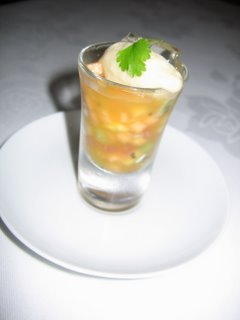 For dessert there were a few options that caught my eye: quince feuillette, Valrhona and Armagnac trifle, warm rum baba, passionfruit sable or the chestnut soufflé not on the menu but presented on special order to the table of regulars next to me (when I asked about it Georgia North was happy to oblige). In the end I chose a rhubarb and sherry tart ($19).
For dessert there were a few options that caught my eye: quince feuillette, Valrhona and Armagnac trifle, warm rum baba, passionfruit sable or the chestnut soufflé not on the menu but presented on special order to the table of regulars next to me (when I asked about it Georgia North was happy to oblige). In the end I chose a rhubarb and sherry tart ($19). When the tart arrived I was a little disappointed. No where had the menu mentioned custard and this tart was very much a flat version of a crème brûlée – thin pastry topped with a warm sherry fino infused custard and a burnt toffee surface. Wafer thin pieces of rhubarb went undetected in the custard and were almost an after thought. It was good, it just wasn’t want I had expected or wanted.
When the tart arrived I was a little disappointed. No where had the menu mentioned custard and this tart was very much a flat version of a crème brûlée – thin pastry topped with a warm sherry fino infused custard and a burnt toffee surface. Wafer thin pieces of rhubarb went undetected in the custard and were almost an after thought. It was good, it just wasn’t want I had expected or wanted.
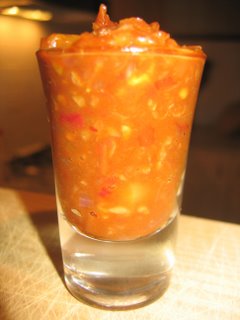
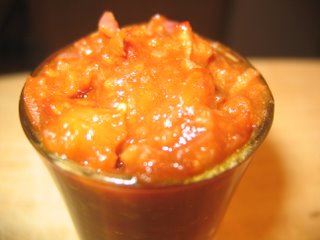

 But now I am free to make them, free to try whatever I want. I’m like a kid in a candy store and I don’t know what to devour first. My only problem now is trying to find all those forgotten meaty recipes again!
But now I am free to make them, free to try whatever I want. I’m like a kid in a candy store and I don’t know what to devour first. My only problem now is trying to find all those forgotten meaty recipes again!

 I started my birthday dinner off in La Sala's swanky bar area with a blood peach bellini ($14), the traditional nectar and prosecco aperitif. The peaches were a little unripe but the bar had done an excellent job of sweetening them subtly so it was almost undetectable.
I started my birthday dinner off in La Sala's swanky bar area with a blood peach bellini ($14), the traditional nectar and prosecco aperitif. The peaches were a little unripe but the bar had done an excellent job of sweetening them subtly so it was almost undetectable.













 These wonderful little molluscs have been on my mind a fair bit lately. In Australia we use the words clams and vongole interchangeably because it seems that the Italians introduced this delicious bivalve to the Aussie diet.
These wonderful little molluscs have been on my mind a fair bit lately. In Australia we use the words clams and vongole interchangeably because it seems that the Italians introduced this delicious bivalve to the Aussie diet.